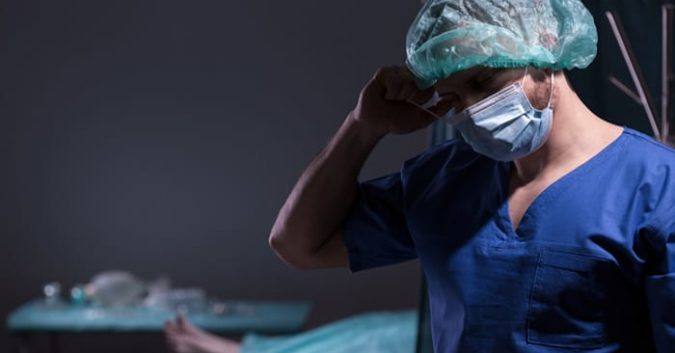If the U.S. government took only 1 percent of the money funneled into terrorism prevention, instead using it to improve patient safety, the department of health could save an exponentially higher number of lives. Considering post-9/11 terrorism activity has only been enough to kill an average of 1 American per year, it could be argued that these funds might be better spent preventing 251,000 annual deaths by medical error.
Indeed, this was the number estimated by John Hopkins University School of Medicine in a 2016 study, which found medical errors to be the nation’s third leading cause of death.
Research unearthed the alarming reality of today’s healthcare: medical facilities failing patients time and time again with misdiagnoses, administering the wrong drugs, performing wrong-site procedures, causing injuries and infections, and adverse events during childbirth.
Yet the story is far from over. More than a year after these findings were published, researchers have seen little-to-no improvement in the situation. Instead, other factors have threatened to make circumstances worse.
The Medical Malpractice Epidemic
Calling it an “epidemic” is not hyperbole. Questioning the safeness of a place dedicated to treating disease and saving lives shouldn’t be necessary. Yet hospitals around the country are falling short of providing adequate care in many ways. In response, government and healthcare providers are doing little to prevent mishaps and a lot to keep them hidden, making medical error an ongoing problem that the public cannot fully understand.
Dr. Martin Makary, professor of surgery and lead researcher of the John Hopkins study, found evidence of roughly 700 medical error-caused deaths per day: a full 2-3 times higher than previously thought and more than Alzheimer’s disease, diabetes, influenza, and pneumonia deaths combined. Later that year, his evaluation was supported by the U.S. Food and Drug Administration (FDA), which found that medication-related errors alone kill at least 1 person every day and injure another 1.3 million each year.
Perhaps more disturbing than these figures is the fact that each of those deaths was likely avoidable. Doctors are bound to make mistakes from time to time. But the frequency is so high, and the reasons so infuriating, that they can hardly be dismissed as simple human error.
The Truth Behind Medical Errors
In looking into such reasons, further research has suggested a host of possibilities: poor communication between doctors, ambiguities or inaccuracies in patient records, second-rate practices or techniques, lack of training, and providing patients and the public with false or misleading information.
Recent developments have given rise to a cause even less acceptable: smartphone use. Mobile devices are often utilized in the operating room to allow access to important medical software or to make emergency calls. Used wisely, cell phones can provide life-saving information in an instant. But in the wrong hands, they can put a patient’s life in jeopardy.
In 2014, 1 such patient never made it through a routine heart procedure. Investigations found that the 61-year-old’s anesthesiologist had used his iPad over 50 times during surgery to text, surf the internet, and even take pictures. According to witnesses, the anesthesiologist didn’t notice the patient’s critically low oxygen levels until up to 20 minutes after she “turned blue.”
In another case, a Seattle doctor was suspended after sending upward of 200 “sexts” – or sexually explicit text messages – during a series of procedures. These even included Caesarean deliveries, during which he could have put infants at serious risk of birth injury.
Mobile Technology: The Solution or the Problem?
The answer seems simple: for hospitals to monitor, or entirely disconnect, doctors’ cell phone privileges. Unfortunately, there’s a catch. Even if hospitals had measures in place to control personal device use – and they don’t – this may deny access to digital healthcare systems we now rely upon heavily.
On the other hand, personal device access is not without its downfalls. In addition to distraction, as demonstrated in the above cases, studies have found that cell phones increase risks of infection. The dangers of bringing bacteria into sterile hospital environments indicate the need for stronger hand hygiene at the very least.
Cell phones also present privacy and security issues. According to a 2016 report, 14 percent of doctors store unprotected patient data on their cell phones. Another 60 percent transfer sensitive data via text message, and 25 million doctors use medical apps infected with malware. Further research showed that 82 percent of hospitals are concerned about their ability to prevent cyberattacks.
“These communications do not have the proper security to protect patient information,” said Dr. Manny Alvarez, chairman of the department of obstetrics/gynecology and reproductive science at Hackensack University Medical Center. “Recent security breaches in the healthcare industry hold serious concern as hundreds of medical organizations deal with them.”
Ironically, healthcare providers are exploring technology’s capability to prevent medical malpractice. For example, Brigham and Women’s Hospital is using web tools to streamline patient handoff, which involved 77 errors between 2012 and 2013. But how much power do such tools really have to prevent deadly errors?
Hospitals’ Duty to Reinforce Operations
As of yet, it’s uncertain how much mobile devices contribute to medical malpractice, but they do pose a clear threat. No matter how hospitals might justify their lack of supervision, greater attention to personal and hospital-owned device use is common sense. If hospitals are willing to invest more into health information technology and mobile communications, they should also be prepared to invest in safeguarding patient data – and more urgently, their lives.
“Doctors should do everything within their power to stay alert and decrease infections during surgery,” said Alvarez. “Staying off their devices will ensure this level of excellence. Hospitals and doctors should work together to put a strategy in place and enforce it. After all, patient safety is at stake.”
